What is Publish/Subscribe
Overview
Publish/Subscribe is a system where peers congregate around topics they are interested in. Peers interested in a topic are said to be subscribed to that topic:

Peers can send messages to topics. Each message gets delivered to all peers subscribed to the topic:

Example uses of pub/sub:
- Chat rooms. Each room is a pub/sub topic and clients post chat messages to which are received by all other clients in the room.
- File sharing. Each pub/sub topic represents a file that can be downloaded. Uploaders and downloaders advertise which pieces of the file they have in the pub/sub topic and coordinate downloads that will happen outside the pub/sub system.
Design goals
In a peer-to-peer pub/sub system all peers participate in delivering messages throughout the network. There are several different designs for peer-to-peer pub/sub systems which offer different trade-offs. Desirable properties include:
- Reliability: All messages get delivered to all peers subscribed to the topic.
- Speed: Messages are delivered quickly.
- Efficiency: The network is not flooded with excess copies of messages.
- Resilience: Peers can join and leave the network without disrupting it. There is no central point of failure.
- Scale: Topics can have enormous numbers of subscribers and handle a large throughput of messages.
- Simplicity: The system is simple to understand and implement. Each peer only needs to remember a small amount of state.
libp2p currently uses a design called gossipsub. It is named after the fact that peers gossip to each other about which messages they have seen and use this information to maintain a message delivery network.
Discovery
Before a peer can subscribe to a topic it must find other peers and establish network connections with them. The pub/sub system doesn’t have any way to discover peers by itself. Instead, it relies upon the application to find new peers on its behalf, a process called ambient peer discovery.
Potential methods for discovering peers include:
- Distributed hash tables
- Local network broadcasts
- Exchanging peer lists with existing peers
- Centralized trackers or rendezvous points
- Lists of bootstrap peers
For example, in a BitTorrent application, most of the above methods would already be used in the process of downloading files. By reusing peers found while the BitTorrent application goes about its regular business, the application could build up a robust pub/sub network too.
Discovered peers are asked if they support the pub/sub protocol, and if so, are added to the pub/sub network.
Types of peering
In gossipsub, peers connect to each other via either full-message peerings or metadata-only peerings. The overall network structure is made up of these two networks:
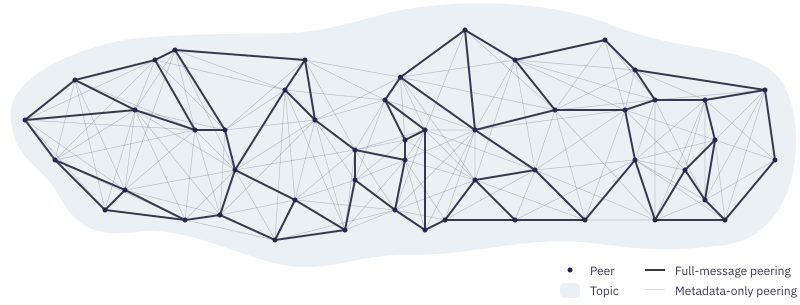
Full-message
Full-message peerings are used to transmit the full contents of messages throughout the network. This network is sparsely-connected with each peer only being connected to a few other peers. (In the gossipsub specification this sparsely-connected network is called a mesh and peers within it are called mesh members.)
Limiting the number of full-message peerings is useful because it keeps the amount of network traffic under control; each peer only forwards messages to a few other peers, rather than all of them. Each peer has a target number of peers it wants to be connected to. In this example each peer would ideally like to be connected to 3 other peers, but would settle for 2–4 connections:
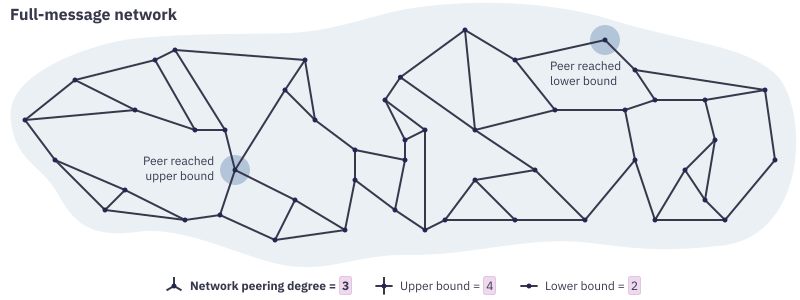
The peering degree (also called the network degree or D) controls the trade-off between speed, reliability, resilience and efficiency of the network. A higher peering degree helps messages get delivered faster, with a better chance of reaching all subscribers and with less chance of any peer disrupting the network by leaving. However, a high peering degree also causes additional redundant copies of each message to be sent throughout the network, increasing the bandwidth required to participate in the network.
In libp2p’s default implementation the ideal network peering degree is 6 with anywhere from 4–12 being acceptable.
Metadata-only
In addition to the sparsely-connected network of full-message peerings, there is also a densely-connected network of metadata-only peerings. This network is made up of all the network connections between peers that aren’t full-message peerings.
The metadata-only network shares gossip about which messages are available and performs functions to help maintain the network of full-message peerings.

Grafting and pruning
Peerings are bidirectional, meaning that for any two connected peers, both peers consider their connection to be full-message or both peers consider their connection to be metadata-only.
Either peer can change the connection type by notifying the other. Grafting is the process of converting a metadata-only connection to full-message. Pruning is the opposite process; converting a full-message peering to metadata-only:

When a peer has too few full-message peerings it will randomly graft some of its metadata-only peerings to become full-message peerings:
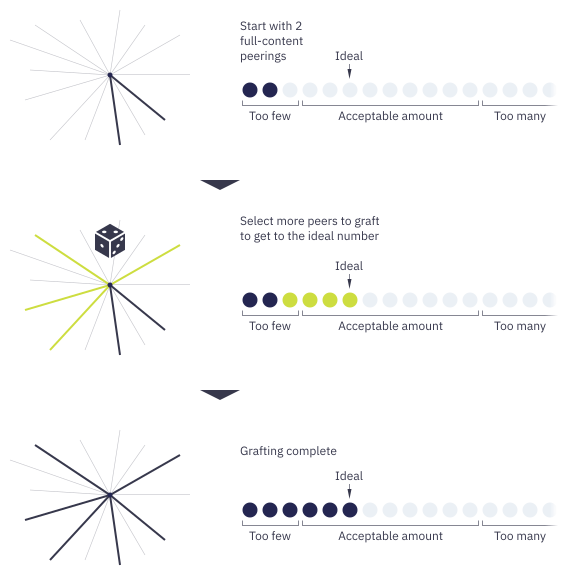
Conversely, when a peer has too many full-message peerings it will randomly prune some of them back to metadata-only:
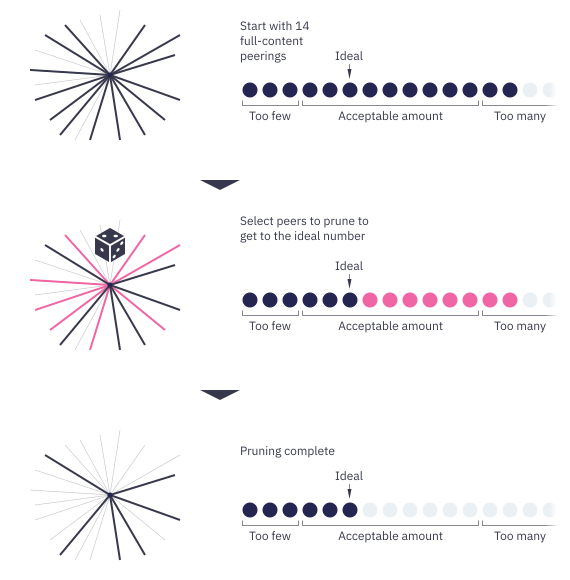
In libp2p’s implementation, each peer performs a series of checks every 1 second. These checks are called the heartbeat. Grafting and pruning happens during this time.
Subscribing and unsubscribing
Peers keep track of which topics their directly-connected peers are subscribed to. Using this information each peer is able to build up a picture of the topics around them and which peers are subscribed to each topic:
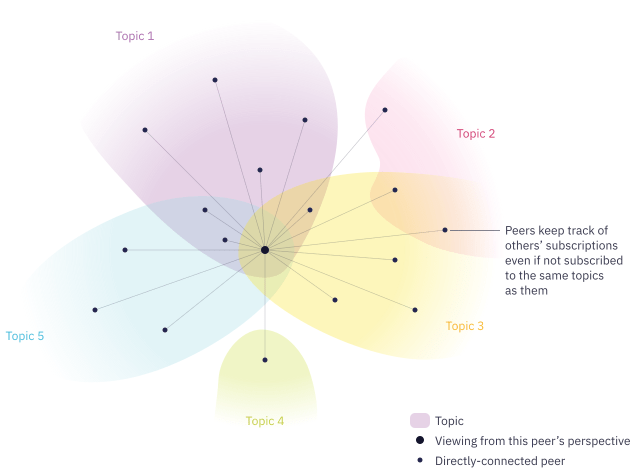
Keeping track of subscriptions happens by sending subscribe and unsubscribe messages. When a new connection is established between two peers they start by sending each other the list of topics they are subscribed to:
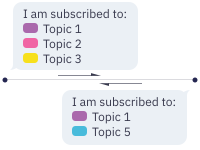
Then over time, whenever a peer subscribes or unsubscribes from a topic, it will send each of its peers a subscribe or unsubscribe message. These messages are sent to all connected peers regardless of whether the receiving peer is subscribed to the topic in question:
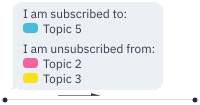
Subscribe and unsubscribe messages go hand-in-hand with graft and prune messages. When a peer subscribes to a topic it will pick some peers that will become its full-message peers for that topic and send them graft messages at the same time as their subscribe messages:

When a peer unsubscribes from a topic it will notify its full-message peers that their connection has been pruned at the same time as sending their unsubscribe messages:
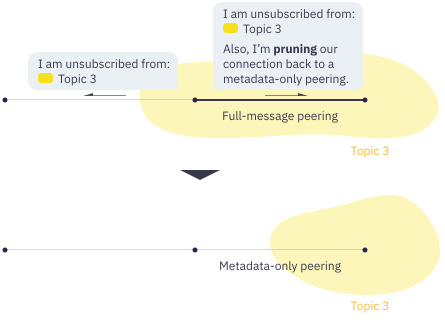
Sending messages
When a peer wants to publish a message it sends a copy to all full-message peers it is connected to:
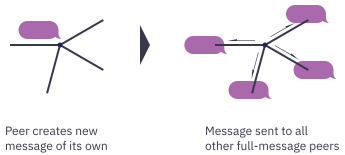
Similarly, when a peer receives a new message from another peer, it stores the message and forwards a copy to all other full-message peers it is connected to:

In the gossipsub specification, peers are also known as routers because of this function they have in routing messages through the network.
Peers remember a list of recently seen messages. This lets peers act upon a message only the first time they see it and ignore retransmissions of already seen messages.
Peers might also choose to validate the contents of each message received. What counts as valid and invalid depends on the application. For example, a chat application might enforce that all messages must be shorter than 100 characters. If the application tells libp2p that a message is invalid then that message will be dropped and not replicated further through the network.
Gossip
Peers gossip about messages they have recently seen. Every 1 second each peer randomly selects 6 metadata-only peers and sends them a list of recently seen messages.

Gossiping gives peers a chance to notice in case they missed a message on the full-message network. If a peer notices it is repeatedly missing messages then it can set up new full-message peerings with peers that do have the messages.
Here is an example of how a specific message can be requested across a metadata-only peering:

In the gossipsub specification, gossip announcing recently seen messages are called IHAVE messages and requests for specific messages are called IWANT messages.
Fan-out
Peers are allowed to publish messages to topics they are not subscribed to. There are some special rules about how to do this to help ensure these messages are delivered reliably.
The first time a peer wants to publish a message to a topic it is not subscribed to, it randomly picks 6 peers (3 shown below) that are subscribed to that topic and remembers them as fan-out peers for that topic:
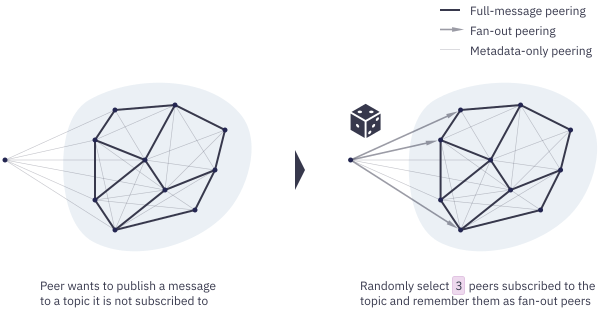
Unlike the other types of peering, fan-out peerings are unidirectional; they always point from the peer outside the topic to a peer subscribed to the topic. Peers subscribed to the topic are not told that they have been selected and still treat the connection as any other metadata-only peering.
Each time the sender wants to send a message, it sends the message to its fan-out peers, who then distribute the message within the topic:
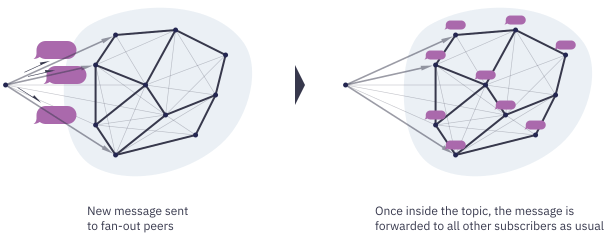
If the sender goes to send a message but notices some of their fan-out peers went away since last time, they will randomly select additional fan-out peers to top them back up to 6.
When a peer subscribes to a topic, if it already has some fan-out peers it will prefer them to become the full-message peers:
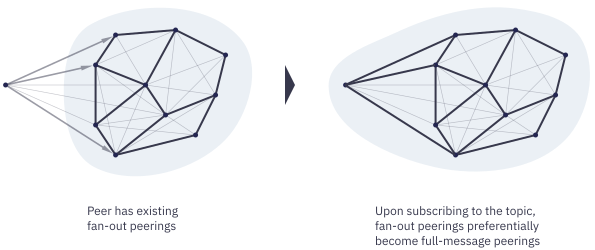
After 2 minutes of not sending any messages to a topic, all the fan-out peers for that topic are forgotten:
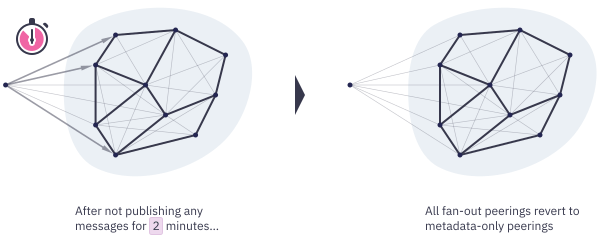
Network packets
The packets that peers actually send each other over the network are a combination of all the different message types seen in this guide (application messages, have/want, subscribe/unsubscribe, graft/prune). This structure allows several different requests to be batched up and sent in a single network packet.
Here is a graphical representation of the overall network packet structure:
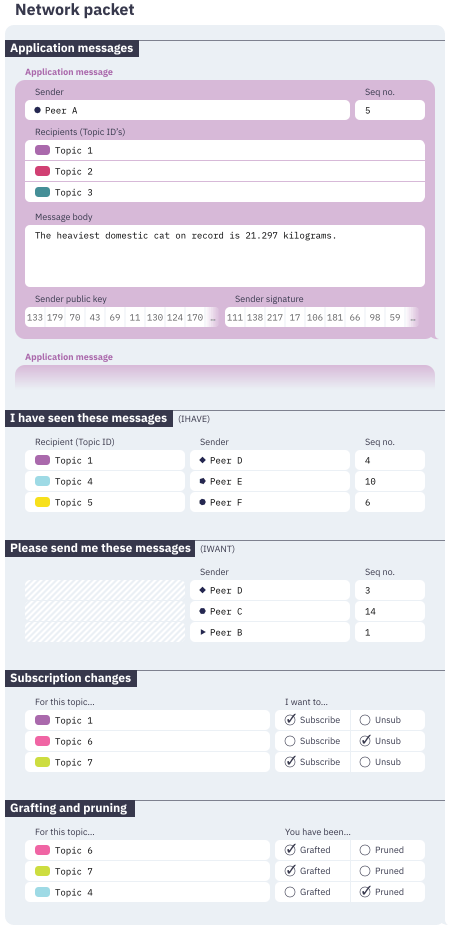
See the specification for the exact Protocol Buffers schema used to encode network packets.
State
Here is a summary of the state each peer must remember to participate in the pub/sub network:
- Subscriptions: List of topics subscribed to.
- Fan-out topics: These are the topics messaged recently but not subscribed to. For each topic the time of the last sent message to that topic is remembered.
- List of peers currently connected to: For each peer connected to, the state includes all the topics they are subscribed to and whether the peering for each topic is full-content, metadata-only or fan-out.
- Recently seen messages: This is a cache of recently seen messages. It is used to detect and ignore retransmitted messages. For each message the state includes who sent it and the sequence number, which is enough to uniquely identify any message. For very recent messages, the full message contents is kept so that it can be sent to any peers that request the message.

More information
For more detail and a discussion of other pub/sub designs that influenced the design of gossipsub, see the gossipsub specification.
For implementation details, see the gossipsub.go file in the source code of go-libp2p-pubsub, which is the canonical implementation of gossipsub in libp2p.